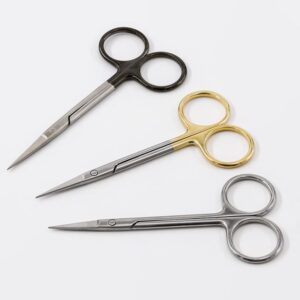What are Ophthalmic Surgical Scissors?
Ophthalmic surgical scissors are surgical instruments used in eye surgery to cut and separate eye tissue. ophthalmic surgical scissors usually consist of two parts, the body of the scissors is shorter and the mouth of the scissors is longer with a sharp curved shape, which is suitable for the narrow and winding surgical area of the eye.
Ophthalmic surgical scissors are categorized into different types according to the shape and size of the nozzles, such as straight, curved, pointed, flat, etc. Different types of scissors are used for different purposes. Different types of scissors are used for different eye surgeries, and the surgeon will choose the right type of eye scissors according to the needs of the surgery.
It is important to note that ophthalmic surgical scissors are very delicate surgical instruments and need to be used under strict sterile conditions to avoid infection and cross-infection. Doctors need to be very careful when using eye clippers to avoid unnecessary damage to the patient’s eyes.
Ophthalmic Surgical Scissors Specifications/Models
There are many sizes and models of ophthalmic surgical scissors, and different sizes and models are used for different eye surgeries. The following are common specifications and models of ophthalmic surgical scissors:
1、Straight blade type ophthalmic surgical scissors: about 8.5cm in length, with a straight scissors mouth, suitable for cutting and separating ocular tissues.
2, curved blade type ophthalmic surgical scissors: length of about 8.5cm, scissors mouth is curved, suitable for eye cornea and sclera and other tissues of the surgery.
3, pointed-type ophthalmic surgical scissors: length of about 10cm, the scissors’ mouth more slender, suitable for eye surgery of small tissues, such as eyelid surgery.
4, flat head type eye scissors: length of about 10cm, scissors flat mouth, suitable for eye soft tissue surgery, such as conjunctival surgery. It should be noted that different eye clipper specifications and models should be selected according to the needs of the operation, the doctor based on the patient’s condition, surgical site and surgical purpose, and other factors to choose the appropriate eye clippers, in order to ensure that the effect of the operation and safety.
Classification of Ophthalmic Surgical Scissors
Ophthalmic surgical scissors are an essential tool used by ophthalmologists for the management of eye surgery, trauma, infection, and inflammation. They consist of scissors (knives) and forceps with sharp, stable edges that easily remove any tissue from the conjunctival sac, including the wall of the eyeball.
Ophthalmic surgical scissors are usually categorized into three types.
- Single-edged
This type is used for manipulation of the corneal epithelium or anterior elastic lamina, e.g., in the management of corneal foreign bodies, which need to be removed from the eye.
- Triple-blade type
This type of scissors is used in the deep or posterior elastic layer of the cornea. For example, when performing a scleral ring implant, an incision is made in the bulbar conjunctiva. This type of multi-blade scissors is more flexible and easier to maneuver than the single-blade type.
- Multi-head
Multi-blade scissors are very flexible scissors that can be used for a variety of purposes.
Notes on Ophthalmic Surgical Scissors
- In the process of use, hands must be kept clean to prevent cross-infection.
- In the process of use, the principle of aseptic technique must be strictly observed to avoid contamination.
- In the process of use, if there is an abnormal situation, should immediately stop using.
Ophthalmic Surgical Scissors Effect and Functions
Ophthalmic surgical scissors are a kind of surgical instrument specially used for eye surgery, the main function is to cut and separate eye tissues, when used for eye surgery, it can realize the following effects:
1, cut and cut the tissue: eye scissors with very sharp scissors mouth, can easily cut and cut the eye tissue, used for eye surgery, can quickly and accurately for tissue processing.
2、Separation of tissues: eye scissors can accurately separate the eye tissues, which can be used for surgery to separate and process the tissues in a very delicate way, avoiding unnecessary damage and injury to the surrounding tissues.
3、Assisted surgical operation: eye scissors are a kind of auxiliary surgical instrument, that can be used to cooperate with other instruments, to assist in completing the operation of eye surgery, and improve the effect and safety of surgery.
4, fine operation: eye scissors with fine and small features, can adapt to the eye’s small and winding surgical area, for surgery can be fine cutting and separation of eye tissues, improve the accuracy and success rate of surgery. In short, eye scissors are a very important ocular surgical instrument, that can realize fine, safe, and effective surgical operation, used in eye surgery can play an important role and efficacy.
Ophthalmic Surgical Scissors Features
1, small and delicate: eye scissors body is shorter, scissors mouth is longer, sharp curve, suitable for eye surgery in small and curved areas, with fine, precise characteristics.
2, a variety of specifications and models: eye scissors specifications and models, different specifications and models for different eye surgeries, the doctor can choose the appropriate eye scissors according to the needs of the operation.
3, safe and reliable: eye clippers are professional medical instruments, used in eye surgery very safe and reliable, and can effectively reduce the risk of surgery and the occurrence of complications.
How Are Ophthalmic Surgical Scissors Used?
1、Preparation: Before the surgery, the doctor needs to sterilize and aseptically process the eye clippers to ensure that the instruments are clean and hygienic. At the same time, the doctor needs to prepare other instruments and medicines needed for the surgery.
2、Pre-operation examination: Before using the eye clippers, the doctor needs to examine the patient’s eyes to confirm the surgical site and the purpose of the operation, in order to determine what type and specification of the eye clippers to be used.
3、Use of ophthalmic surgical scissors: When using ophthalmic surgical scissors, the surgeon needs to place the body of the scissors in one hand and the nozzle of the scissors in the other, and insert the nozzle of the ophthalmic surgical scissors into the eye tissues slowly and gently to cut and separate the tissues.
4, control the strength and direction: when using the eye scissors, the doctor needs to control the strength and direction of the scissors to avoid unnecessary damage to the surrounding tissues. At the same time, special care should be taken during the operation to avoid damage to the patient’s eyeball and other vital organs.
5, pay attention to the hygiene of the operation process: in the use of ophthalmic surgical scissors, the doctor needs to pay attention to the hygiene of the operation process, to avoid damage to the tissues of the surgical area and cause infections and other adverse reactions.
6, after the operation is completed: after the operation, the doctor needs to use the eye clippers for aseptic treatment and disinfection, to ensure that the instruments are clean and hygienic, safe and reliable. It should be noted that ophthalmic surgical scissors a very delicate surgical instrument, need to be used under strict sterile conditions to avoid infection and cross-infection. When using ophthalmic surgical scissors, doctors need to be very careful to avoid unnecessary damage and injury to the patient’s eyes.
How are ophthalmic surgical scissors different from regular scissors?
Ophthalmic surgical scissors are an essential tool in the practice of ophthalmic surgery. These specialized scissors are specifically designed for use in delicate eye surgeries, with features that set them apart from regular scissors.
The first notable difference between ophthalmic surgical scissors and regular scissors is their size and shape. Ophthalmic surgical scissors are smaller and more delicate, with finer tips that allow for precise movements in the small and sensitive space of the eye. They also have longer handles, which provide better leverage and control during delicate procedures.
In addition to its size, another important feature of ophthalmic surgical scissors is its design. Unlike regular scissors, these instruments have curved or angled blades that allow for better visibility and access to hard-to-reach areas within the eye. Their sharp, pointed tips also make it easier to maneuver around blood vessels and nerves without causing any damage.
Moreover, ophthalmic surgical scissors are made using high-quality materials such as stainless steel or titanium. This ensures that they are durable, rust-resistant, and able to withstand repeated use and sterilization processes without losing their sharpness or precision. Regular household scissors may not be strong enough to handle the delicate tissues of the eye and may dull quickly after multiple uses.
What makes ophthalmic surgical scissors truly unique is their purposeful ground micro-serrations on their cutting edge. These tiny serrations help ensure a clean cut by holding onto the tissue while cutting, preventing it from slipping or tearing during surgery. In contrast, regular household scissors typically have smooth edges that can easily cause damage to fragile tissues when used on intricate structures like those found in the eyes.
Ophthalmic surgical scissors are specially designed instruments with smaller sizes, unique shapes, and sharper edges that make them essential tools for eye surgeries. Their high-quality material and ground micro-serrations make them the perfect scissors for precision cutting in delicate procedures. It’s these distinct features that set them apart from regular scissors and make them an indispensable tool for ophthalmologists and surgeons around the world.
Why are they important in eye surgery?
Ophthalmic surgical scissors play a crucial role in eye surgery, as they are specifically designed to make precise and delicate cuts in the eye tissue. These scissors come in a variety of shapes and sizes, each designed for a specific purpose during the surgical procedure. In this section, we will delve into the different types of ophthalmic surgical scissors and their importance in eye surgery.
One of the most commonly used ophthalmic surgical scissors is the 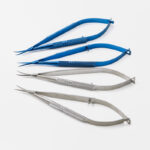
Another type of ophthalmic scissor is called Vannas scissor, which has curved blades with extremely sharp tips. They are primarily used for trimming delicate structures such as nerves and blood vessels near the eye surface without causing any damage to surrounding tissues. The curved shape of these scissors also makes them ideal for operating in hard-to-reach areas within the eye.
One important consideration while using ophthalmic surgical scissors is their size. Microsurgical procedures, like cataract surgery, often require incredibly small incisions that are difficult to achieve with standard-sized instruments. For these procedures, smaller versions of ophthalmic surgical scissors known as Stevens Tenotomy Scissors are used. These tiny but sharp scissors allow surgeons to make precise cuts without damaging surrounding tissues.
Besides being available in different sizes and shapes, some specialized ophthalmic surgical scissors also have unique features that cater to specific needs during surgery. For instance, Westcott spring microscissors have a self-opening mechanism that enables surgeons to operate single-handedly while keeping their other hands free for other tasks. These scissors are useful in procedures like membrane peeling or iris manipulation, where precise cutting is required.
Ophthalmic surgical scissors are critical instruments in eye surgery as they allow for precise and delicate cuts without damaging the surrounding tissues. With advancements in technology and design, these scissors continue to evolve, providing surgeons with a variety of choices to suit their specific surgical needs. From simple incisions to intricate dissections, ophthalmic surgical scissors play an essential role in achieving successful outcomes in eye surgeries.

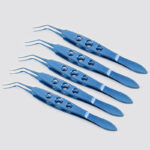 Capsulorhexis Forceps
Capsulorhexis Forceps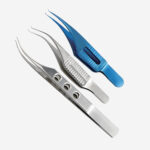 Suture Forceps
Suture Forceps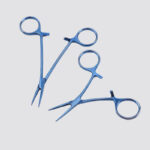 Hemostatic Forceps
Hemostatic Forceps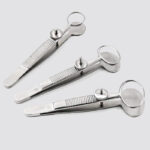 Chalazion Forceps
Chalazion Forceps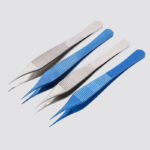 Adson Forceps
Adson Forceps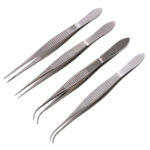 Tissue Forceps
Tissue Forceps
